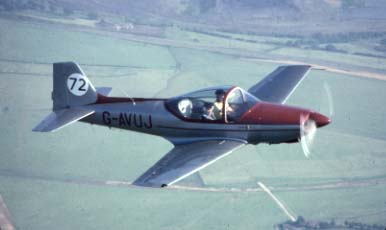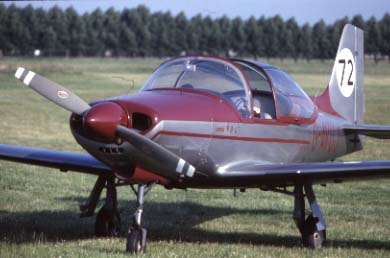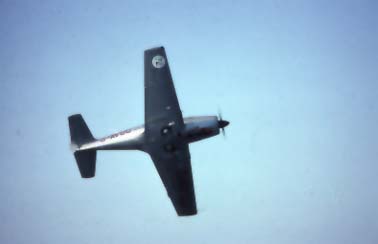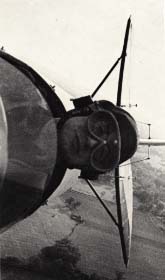Flight Report:
The F.8L Falco
![]()
Flight Report:
|
|
|
by James Gilbert |
Heave back the doors of the dark and sleeping hangar and you reveal a jumble of shapes of the tight-packed planes inside: wings, tails, fins, props-like patterns in an abstract painting. Yet the Falco stands out, seizes your eyes. Wheel her out, brakes squeaking, into the low morning sun, and look at her more thoughtfully: here is a plane of almost sculptured beauty of line. That low-set wing of such small dihedral is not only faired and blended into the narrow fuselage but tapered two ways: in chord, and in airfoil thickness as well, 12-1/2% at the roots, only 10% at the tips. The teardrop canopy is the classic minimum-drag form combined with a fighter pilot's visibility. Did you ever see a Lycoming so gracefully and slenderly cowled? Even the landing gear is slender and delicate. Here is an obviously unusual airplane, and one that whispers to you, s-p-e-e-d.

Fast the Falco is: nudging 200 mph at sea level and full power, 180 mph at 75% power cruise at altitude-on a 160 hp engine. There's a popular yardstick for lightplanes that if one will do one mile an hour of cruise speed for every horsepower, that's true efficiency. In truth this doesn't work too well, for drag-and therefore power required-increases as the square of the speed. Plenty of 100 hp planes will do 100 mph; but not many 200 hp ones will do 200 mph. But I defy you to find many 160 hp airplanes that will cruise at 180 mph. That is something.
The Falco's delicious looks are part aesthetic, part aerodynamic. Her designer, Stelio Frati, is an Italian, and the look and shape of an artifact are of the utmost visual importance to an Italian. And if, as designer, you meld and blend each part of your plane into the next, seeing drag forever as the enemy you must conquer through sleekness and streamlining, said airplane is likely to resemble a million dollars for beauty. And the Falco's construction serves further to this end, for it is made of wood, and more wood, all wood, covered with plywood, covered with fabric and doped and polished, till it becomes a sculpture that might be of polished ebony. Not a rivet head in sight; just smoothness.
And at low weights (no baggage, low fuel) this paragon among two-seaters is also aerobatic. Of course a stock 160 hp Lycoming won't run upside down, which is perhaps the only reason no one ever yet won an aerobatic contest in a Falco; but she will do most gracefully all the range of positive g maneuvers: rolls slow, hesitation, barrel and snap; spins; loops; Cuban eights; roll off the top; hammerheads, I think-though the engine might stop at the top.
Every Falco I ever saw was painted in the factory scheme, tasteful silver overall. I can't help feeling they should have been that famous Ferrari red. Do you remember the moment in that deliciously wicked film The Thomas Crown Affair when Steve McQueen turns up to meet someone in a GTB Ferrari (I think it was the twin-cam) and the "someone" inquires: "That one of them red Eyetalian things?" The Falco too is quintessentially "one of them red Italian things."
Come with me and we will go fly the beast. This aircraft is from the last Italian production run-i.e., she has the constant-speed prop and thus does not require such a long run, climbs better, and also does not seem to require so much right boot to keep straight on the climb. Slide back the big canopy and climb aboard. The seat requires you to lean back to fit it, as in some sports cars-an attitude that takes a bit of getting-use-to, unless you are a glider pilot. Though the seat-back rack is not adjustable, the seats do slide fore and aft. The cockpit has a boat-like feel to it, with the walls curving in quite sharply at the bottom beside your feet. Though it is quite narrow, even at elbow level, you don't feel crowded even if you are my size (large). There is a surprising amount of head-room under the wide canopy. This Falco has a horrid three-point harness which I would change pronto for a modern Christen aerobatic one. Even if I never planned to do any aerobatics in my Falco I would still fit a proper aerobatic harness, knowing that the controls are so nice I would be unable to resist the temptation to fling the thing about. Harnesses have improved in the twenty-three years since the Falco first flew.

So have instrument panels, good grief. The one in this Falco is an untidy jumble of dials and radios stuck just anywhere, with a big switch panel taking up much of the room in the center where the radios out to be. The radios themselves are even too long to fit the depth of the panel, and stand an inch proud of it. I think every Falco builder is going to want to redesign the panel to suit himself-and modern instruments and avionics. A Falco's panel is always going to be a tight squeeze by the time you've included DME and transponder (devices not yet in common use when this bird was fledged), but with ingenuity it should be feasible to get it all in neatly.
The panel seems quite far away from you, leaving a great space in which to wave that fine curved stick about. (Why do most production airplanes have yokes? Are they not daft devices? I suppose they made sense when ladies of fashion wore long tight pencil shirts and simply could not fit into the pilot's seat of a plane with a stick. But could not someone tell the people in Wichita that pencil skirts are now out?) The stick is a tall one, giving you a good mechanical advantage for your control inputs; the gun-button on top of it is in fact the press-to-transmit waiting for your thumb. The brakes are worked by a long lever not unlike the Trimotor's ancient Johnson bar down by your left: you twist-grip it to release it like a helicopter's collective or a motorcycle's throttle. H'mm. An antiquated arrangement: I'd want to replace it with toe-brakes if I could-if there's room.
You'll look in vain for the fuel pump switch: there isn't one. There's no electric fuel pump. The engine will happily feed itself by gravity off the front tank should the engine pump fail-which is why you take off and land on the front tank. But a low-wing airplane with no aux pump has me hunting around thinking I've forgotten something vital during my checks. Gear and flap switches are simple domestic tumbler style; again I'd look for modern shaped ones to replace them in my Falco. I might also go for quadrant instead of plunger engine controls. Actually, we may bitch about how the design of light aircraft hasn't changed any in twenty-five years-and aerodynamically, it hardly has-but the advances in cockpit layout, avionics and instrumentation have been considerable, very considerable. No reason why any homebuilder shouldn't incorporate the best of these modern advances, to suit his taste, in his Falco.
One little vintage touch I'd leave is the back-up gear position indication: besides the green all-down light there are mechanical indicators, little orange markers like big thumb-tacks that pop up from each wing and the nose to show beyond doubt that the gear is down.
Jiggle the throttle to prime before starting. She taxies easily, with the nosewheel steering high-geared and firm. She pitches and bounces on rough grass, and is not really a rough-field airplane. (This Falco's owner told me he does not fly his bird from its all-grass home base when the ground is really soft in mid-winter.) For the same reason you should raise the nose early during the take-off. On the climb the rudder on this airplane is not the useless appendage it is on many. A cruise-climb speed of 130 mph gives you far better forward visibility than the actual best-rate speed.
Gear and flaps are both electric (no hydraulics in the airplane): the flaps come up fast, the gear slowly, with a deal of electric whirring noises. You need a steady tad of right rudder to keep the ball in the center but she climbs like a bat. It is as some point in the climbout that it begins to dawn on you that this machine has really the most fabulous controls. I tell you, if you are more used to something like the Cherokee, the Falco is a revelation in handling, the lightness and effectiveness of the controls and the quickness of the response being more like a Formula One racer than a cabin tourer. The ailerons in particular are marvelously sensitive: not overwhelmingly light, but so powerful.... After a few minutes you find you are no longer grasping the stick as for take-off, but just clasping it lightly with your fingertips. The trim, too, is equally high-geared and powerful, and is to be used with care and delicacy.

If the climb feels nose-high, the cruise feels nose-low at first. You can see the ground just a mile or so ahead; and then you get to swiveling your head like an owl as you discover you have perfect visibility right around behind you in angles you wouldn't even think of looking in other aircraft. The Falco has one odd quirk: it starts climbing when you roll into a turn, descending when you roll out.
The last model production Falcos had improved soundproofing, but I feel there is still scope for further improvement. The Falco is certainly not the quietest airplane in the world to ride in: indeed, I don't see how anything with a fighter-style canopy could be. Your red-blooded Italian always likes to hear the motor. European pilots don't rely on cabin speakers as much as Americans: they use padded close-fitting headsets, and I'd suggest you do in your Falco, too. (These have an especial advantage in that they enable you to talk to each other through the intercom circuit at ordinary voice levels, without shouting.)
If you expect a hot ship like the Falco to have a hot stall, well, she hasn't. The stall is a model of what a stall should be, and a good deal gentler than, say, a Bonanza's. Falcos imported into Britain all had stall strakes fitted to the inboard leading edge, and I suggest you should fit these too. It ensures that the inboard wing starts to stall first, so there is a real clatter of buffet before she stalls in all flight conditions as a warning. The airplane flutters and shakes for a while before it stalls: you'd have to be as thick as two short planks to miss what was coming. If you drive through this and persist, she will finally drop a wing, and never the same one each time. The ailerons remain highly effective right down to the stall, even with full flaps.
The Falco is lightly spirally unstable both ways, i.e., drop a wing either side and she tends to roll further and slowly dive away. She is stable in pitch, but not excessively so: after being displaced from trimmed speed by some 15 mph, she'll fly four or five phugoids before returning slowly to it. With full flaps she is about neutrally stable in pitch, which means you must pay attention to the airspeed on finals. The ride at cruise speed through rough air is superb; the Falco seems particularly stable in yaw with the nose down.
You come back again and again to the delight of those controls: it's like flying a tiny jet. Raise the nose, heave the stick sideways and the whole world jumps up and over and down as you barrel-roll. A perfect loop takes practice, till you work out just the right amount of pull required to get her coming nicely over the top. Aerobatics in a Falco are pure joy. But I caution you: if you are not experienced in aerobatics, get some dual before trying them in your Falco. The reason is her very slipperiness: though the redline is at 240 mph quite high, so low is the Falco's drag that it is easy to go thundering through 240 mph during aerobatics if you don't know exactly what you are doing. If you should botch up a roll and decide to pull through, you could find yourself quickly with excessive airspeed and pouring on the g's to pull out-a dangerous combination.
In slow flight she feels comfortable and well under control-though some exhaust fumes start coming into the cabin, spiralling around the fuselage in the slipstream. The big trim wheel, so quick and effective, is just an inch or two far forward, making you reach for it. I wonder if it might be moved back a hair without impinging on the landing gear's motor box, which is between the seats.
Despite its racy looks and performance the Falco is marvelously tractable in the pattern. Reduce the power in good time, remembering that she is reluctant to lose speed; then you are allowed gear down at 125 mph, 20 degrees of flap at 112 mph, full at 100 mph. As with the SF.260, trim changes are slight: in fact if you don't touch the trim that you set for cruise, and hold the small forces through gear and flap lowering till you are down to the 90 mph approach speed, you'll find it's just about the same trim setting as for cruise, clean! All the controls are extremely effective at low speeds, and handling in the pattern is easy. However if you are not used to low-drag airplanes, you may have to work on speed control: speed will tend to wander off that ideal 90 unless you watch it. If you get slow, watch your sink rate; if you come in too fast, expect to float. Hold the nose off at touchdown, as though in a tail-dragger, for the most comfortable arrival. Be prepared for an immediate go-around off your first landing in a Falco; for how can you bear to leave something this good on the ground? You'd be tempted to open the taps and climb up for more! I tell you, this Falco is a plane that could make you late home for lunch.
I also defy you to just walk away from a Falco after flying it. Expect at best to make a reluctant crab-like departure, with many an over-the-shoulder glance at the thing. It's such a pretty airplane it's hard to take your eyes off it!
|
|
 |
James Gilbert is Editor and Publisher of Pilot magazine in England. Prior to that he was Senior Editor of Flying magazine. He is the author of four books: The Great Planes (which includes a section on Frati and his aircraft), The World's Worst Aircraft, The Flier's World, and Skywriting. This flight report on the Laverda Series IV Falco was written in 1978 at the time that we were introducing the then-unknown Falco to the U.S. James Gilbert is a long-time admirer of Stelio Frati, and it was James Gilbert who introduced Frati aircraft to the U.S. There had been a few articles on Frati in Italy and France, but James was the first to write in English about Frati aircraft. Before James Gilbert's articles, the S.F. 260 and the Falco were largely confined to Italy-a few did slip out to England and Germany-and most painted in pastel colors. Now they are flown all over the world and many are painted Ferrari red. Blame it all on James Gilbert, the patron saint of Frati aircraft. |
|
|